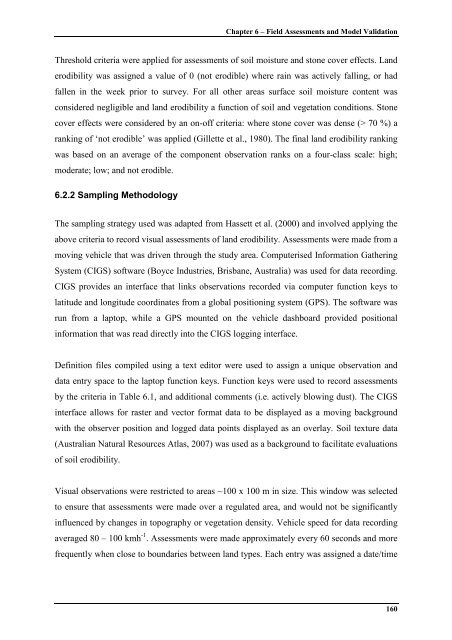Wind Erosion in Western Queensland Australia
Modelling Land Susceptibility to Wind Erosion in Western ... - Ninti One
Modelling Land Susceptibility to Wind Erosion in Western ... - Ninti One
You also want an ePaper? Increase the reach of your titles
YUMPU automatically turns print PDFs into web optimized ePapers that Google loves.
Chapter 6 – Field Assessments and Model ValidationThreshold criteria were applied for assessments of soil moisture and stone cover effects. Landerodibility was assigned a value of 0 (not erodible) where ra<strong>in</strong> was actively fall<strong>in</strong>g, or hadfallen <strong>in</strong> the week prior to survey. For all other areas surface soil moisture content wasconsidered negligible and land erodibility a function of soil and vegetation conditions. Stonecover effects were considered by an on-off criteria: where stone cover was dense (> 70 %) arank<strong>in</strong>g of ‘not erodible’ was applied (Gillette et al., 1980). The f<strong>in</strong>al land erodibility rank<strong>in</strong>gwas based on an average of the component observation ranks on a four-class scale: high;moderate; low; and not erodible.6.2.2 Sampl<strong>in</strong>g MethodologyThe sampl<strong>in</strong>g strategy used was adapted from Hassett et al. (2000) and <strong>in</strong>volved apply<strong>in</strong>g theabove criteria to record visual assessments of land erodibility. Assessments were made from amov<strong>in</strong>g vehicle that was driven through the study area. Computerised Information Gather<strong>in</strong>gSystem (CIGS) software (Boyce Industries, Brisbane, <strong>Australia</strong>) was used for data record<strong>in</strong>g.CIGS provides an <strong>in</strong>terface that l<strong>in</strong>ks observations recorded via computer function keys tolatitude and longitude coord<strong>in</strong>ates from a global position<strong>in</strong>g system (GPS). The software wasrun from a laptop, while a GPS mounted on the vehicle dashboard provided positional<strong>in</strong>formation that was read directly <strong>in</strong>to the CIGS logg<strong>in</strong>g <strong>in</strong>terface.Def<strong>in</strong>ition files compiled us<strong>in</strong>g a text editor were used to assign a unique observation anddata entry space to the laptop function keys. Function keys were used to record assessmentsby the criteria <strong>in</strong> Table 6.1, and additional comments (i.e. actively blow<strong>in</strong>g dust). The CIGS<strong>in</strong>terface allows for raster and vector format data to be displayed as a mov<strong>in</strong>g backgroundwith the observer position and logged data po<strong>in</strong>ts displayed as an overlay. Soil texture data(<strong>Australia</strong>n Natural Resources Atlas, 2007) was used as a background to facilitate evaluationsof soil erodibility.Visual observations were restricted to areas ~100 x 100 m <strong>in</strong> size. This w<strong>in</strong>dow was selectedto ensure that assessments were made over a regulated area, and would not be significantly<strong>in</strong>fluenced by changes <strong>in</strong> topography or vegetation density. Vehicle speed for data record<strong>in</strong>gaveraged 80 – 100 kmh -1 . Assessments were made approximately every 60 seconds and morefrequently when close to boundaries between land types. Each entry was assigned a date/time160
















